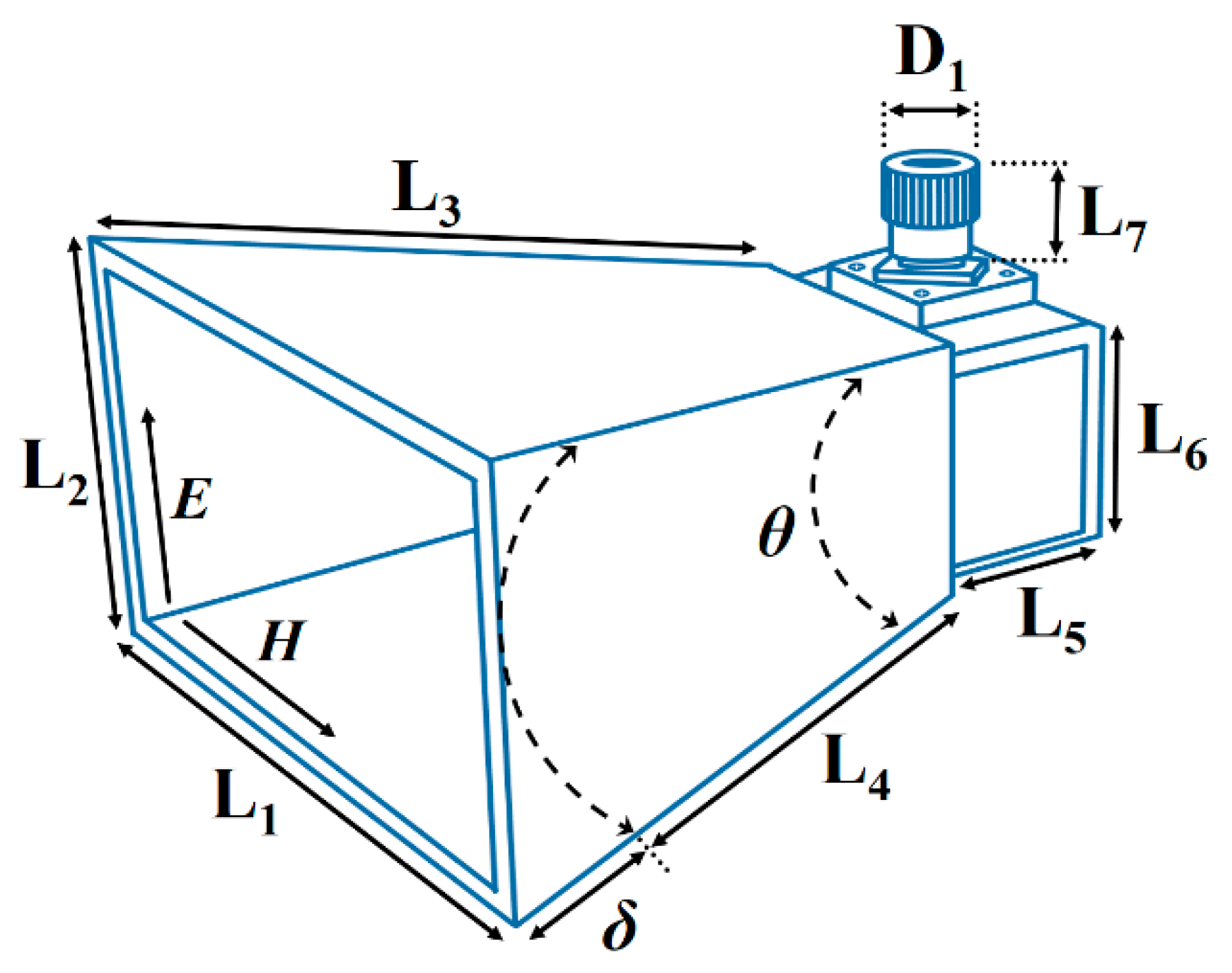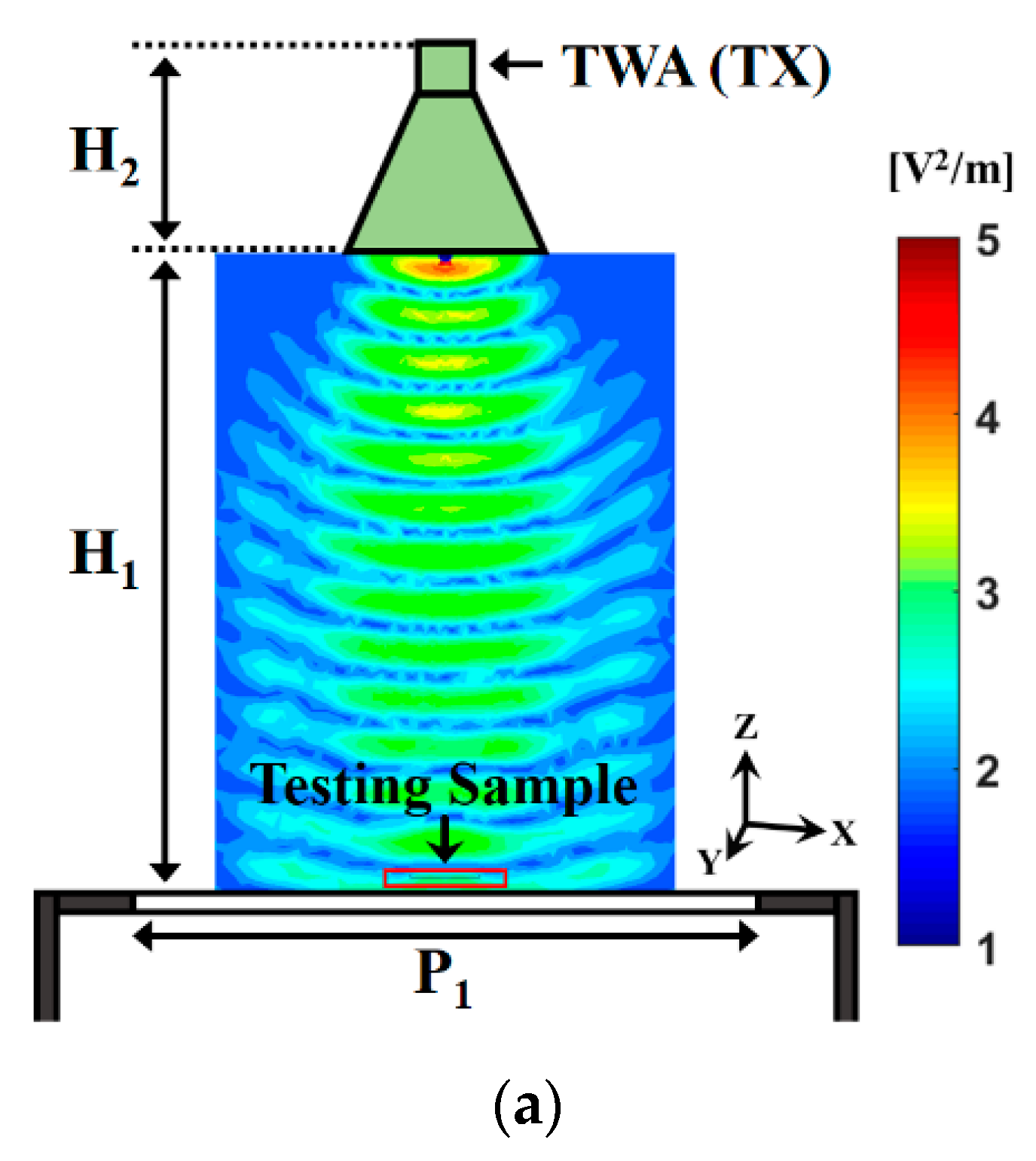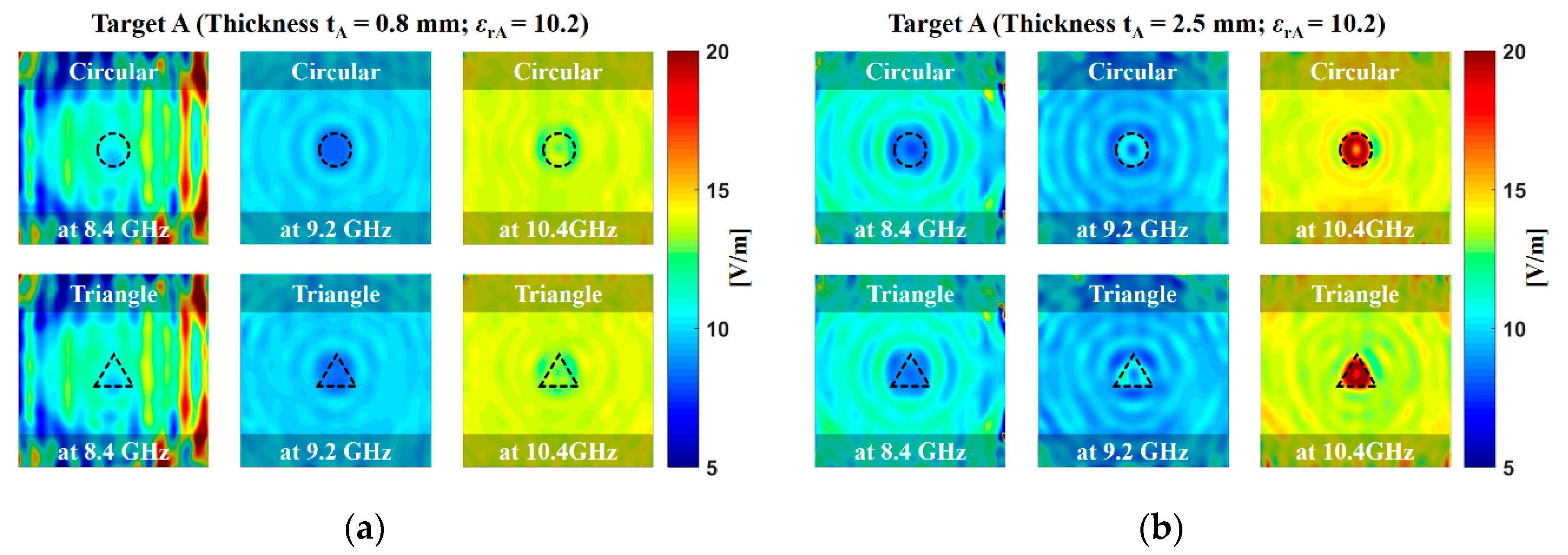1. Introduction
Microwave imaging technology is defined as “roughly and quickly [seeing]” (means for initial rapid screening) the hidden objects in an object’s internal structure by means of electromagnetic fields at microwave frequencies (300 MHz–30 GHz). Microwave imaging technologies and systems have been widely studied and discussed in terms of developing agricultural, safety, industrial, and medicinal applications. Microwave images are maps of the electrical property distributions in dielectric samples [
1,
2].
In the microwave imaging system, the antenna is a crucial component. Moreover, the use of an antenna is a critical aspect and influences the resolution and sensitivity of the output image. In Ahadi et al. [
3], an ultra-wideband (UWB) antenna with UWB characteristics in a medium emulating breast tissue was presented. In Ojaroudi et al. [
4], a UWB printed monopole antenna was proposed for use in a microwave imaging system. The antenna has an optimal radiation pattern, even at higher frequencies, and its radiation efficiency is greater than 86%. In Capobianco et al. [
5], a planar antenna was proposed for use in an imaging antenna array that was operated in a broad frequency range of 3–18 GHz. In Kang et al. [
6], a ground-folded slot antenna was proposed to enhance the gain and reduce the backward radiation of a microwave image. In Yurduseven et al. [
7], a frequency-diverse aperture was proposed for use in a microwave imaging system based on a planar cavity. In the experiment, a number of metal targets were used, including a 2-cm resolution target, a gun phantom, and two L-shaped phantoms. In References [
8,
9,
10], a circular array of antennas with UWB pulses and backscattered signals for early-stage breast cancer detection, a multi-static ultra-wideband antenna array configuration, and a UWB aperture horn antenna raster scanning technique were proposed. These studies have greatly inspired us to consider improving the performance of microwave image systems. However, it is noted that the challenge to improve the efficiency of the antenna and to optimize the high-resolution algorithm in the microwave image system is crucial.
Currently, the Haugh unit (HU) is a commonly used method for classifying the quality of eggs [
11]. According to the conventional HU detection method, the egg must be broken to measure the height of the yolk and albumen; if the eggs are spoiled, moisture in the eggs is lost and the HU can calculate the freshness of eggs [
12]. Dielectric properties as a function of temperature and frequency have been reported for different agricultural commodities, such as grains, seeds, fruits, vegetables, albumen solutions, and thermally denatured albumen gels [
13,
14]. These studies have reported the possibility of destructively predicting the electrical characteristics of agri-food products, such as eggs. In Ragni et al. [
13], the dielectric properties of fresh eggs during storage were investigated. The dielectric properties were determined using an open-ended coaxial probe on the egg yolks after 1–15 days of storage at room temperature. In Guo et al. [
14], the dielectric properties of egg albumen and yolk were apparently distinguished over the frequency range of 10–1800 MHz. However, the conventional HU method has some disadvantages, namely its destructive detection and low accuracy. Moreover, as the storage time of an egg increases, the internal albumen is evaporated into the air through the eggshell, resulting in a decrease in internal albumen capacity. There is no effective method to detect and observe the hidden safety of an egg.
In this study, we proposed a new microwave imaging sensing system and its application toward food security for the first time. A waveguide horn antenna with a metal waveguide as the transmitting waveguide antenna with a scanning frequency range of 7–13 GHz and maximum gain of 17.37 dBi was proposed. The transmitting waveguide antenna could effectively improve the resolution of the imaging samples and the ability to observe the content capacity of the samples. The scanning frequency and dielectric properties of the testing sample were the two aspects of the microwave imaging sensing system that were considered. Additionally, this was the first time a microwave imaging algorithm based on the measured S-parameters for further optimizing and correcting the microwave image deformation was proposed. We first used circular and triangular high-k dielectric materials (with the same thickness but with different dielectric constants) as the testing sample for observing the microwave images of the materials with different dielectric properties, thicknesses, and shape. After confirming the image resolution and efficiency of the waveguide antenna microwave imaging sensing system, a fresh egg and an egg with less albumen (not fresh) were sensed using the microwave imaging sensing system. The sensing results revealed the optimal capability of the system in evaluating the health of eggs. The system can be potentially used in the applications of rapid, non-destructive food security sensing. The proposed system provides a simple, non-destructive, effective, and rapid method for food security applications.
2. Construction and Analysis of the Waveguide Antenna Microwave Imaging Sensing System
The configuration of the transmitting waveguide antenna is displayed in
Figure 1. The waveguide antenna was used as the transmitting waveguide antenna (TWA). The transmitting waveguide antenna consisted of horn-shaped flared metal, which was used to direct radiation waves in the electromagnetic (EM) beam. To design the transmitting waveguide antenna in this study, the critical configuration parameters of the transmitting waveguide antenna were the opening angle
θ, the aperture of the mouth L
2, the length L
4, and the path length difference
δ. From the geometric model, we found that L
4 = L
22/8
δ and
θ = 2cos
−1(L
4/L
4 +
δ). In the
E plane of the transmitting waveguide antenna,
δ was usually about 0.25λ, while in the
H plane of the transmitting waveguide antenna,
δ was about 0.4λ. The radiation pattern and gain of the transmitting waveguide antenna could be decided through adjusting the length L
3 and the opening angle
θ. The characteristics of the proposed transmitting waveguide antenna were then designed and analyzed using an HFSS Simulator (ver. 14.0, Ansoft, Palo Alto, CA, USA). The advantages of the transmitting waveguide antenna were as follows: moderate directivity, low standing wave ratio, wide bandwidth, and simple construction and adjustment. The high directivity horn antenna could reduce the backward radiation to provide good stability in the radiation region and scanning plane. The transmitting waveguide antenna could effectively enhance the resolution of the microwave images. The half-power beam width (HPBW) of the transmitting waveguide antenna was approximately 12.5° in the X–Z and Y–Z planes at each scanning frequency. Based on the design of the HPBW, the optimal resolution region was predicted to be approximately 9.6 × 9.6 cm
2. The S-parameter (−10log|S
11|) of the transmitting waveguide antenna was approximately 10 dB in the frequency range of 7–13 GHz. The frequency was selected by considering safety applications among those envisioned by Federal Communications Commission (FCC) authorization of ultra-wideband technology [
15]. An imaging sensing system may be used for a variety of health applications to “see” an object’s internal structure. The dimensions of the transmitting waveguide antenna were 95 × 78 × 109 mm
3.
The configuration of the waveguide antenna microwave imaging sensing system is displayed in
Figure 2. The transmitting waveguide antenna was installed on top of the system and the receiving waveguide antenna was set on the bottom of the system. The configuration of the waveguide antenna microwave imaging platform was divided into four steps. First, to define the scanning area of the platform, the scanning area of 30 × 30 cm
2 was demonstrated in this study. Second, the effective distance between the transmitting waveguide antenna and the scanning plane for achieving the optimal resolution of the microwave image was determined. Third, the transmitting waveguide antenna radiation angle for covering the entire scanning plane was designed. Fourth, the scope and collection points of the S-shape scanning path of the receiving waveguide antenna to ensure the microwave images were not distorted was determined. To study the resolution and sensitivity of the system, we first used circular and triangular high-
k dielectric materials as the testing sample for observing the microwave images of the materials with different dielectric properties. Target A was a ceramic–polytetrafluoroethylene composite with a dielectric constant (
εrA) of 10.2. Target B was a woven fiberglass cloth and epoxy resin binder with a dielectric constant (
εrB) of 4.4. Targets A and B had thicknesses (t
B) of 0.8 and 2.5 mm, respectively. The scanning frequency of the waveguide antenna microwave imaging sensing system was set to 8.4, 9.2, and 10.4 GHz. The HP 8510C vector network analyzer (Keysight Technologies Inc., Santa Rosa, CA, USA) was connected to a microwave imaging platform. When a high-gain transmitting waveguide antenna passed the signal through the testing sample to receiving end, the receiving waveguide antenna (RWA) needed to match the transmitting waveguide antenna to decrease the radiation interference of both antennas. The receiving waveguide antenna used a rectangular waveguide configuration. The contribution of the receiving waveguide antenna was kept stable to receive the signal from the transmitting waveguide antenna. The receiving waveguide antenna with a scanning frequency range of 7.2–14.3 GHz was used. In addition, the receiving waveguide antenna scanned along the S-shape path for the scanning area (30 × 30 cm
2) within 600 s. A total of 2601 frequency sampling points were extracted as the sum of 51 × 51 scanning points in the X-Y axis.
The measured magnitudes of |S
11| of the transmitting waveguide antenna and receiving waveguide antenna are presented in
Figure 3. The transmitting waveguide antenna was designed to have an |S
11| of more than 10 dB in the frequency range of 7–13 GHz. The receiving waveguide antenna was designed to have an |S
11| of more than 10 dB in the frequency range of 7.6–14.1 GHz. The scanning frequency of the system was set to 8.4, 9.2, and 10.4 GHz. The magnitudes of |S
11| of 27.6 and 17.26 dB, 16.7 and 13.96 dB, and 44.28 and 20.52 dB corresponded to the transmitting waveguide antenna and receiving waveguide antenna at scanning frequencies of 8.4, 9.2, and 10.4 GHz, respectively. The scanning frequency of the waveguide antenna microwave imaging sensing system was related to the quality of microwave image resolution. Through studying the dielectric properties of the high-k materials, it was found that the scanning frequency of 10.4 GHz was useful for enhancing the microwave image resolution.
Figure 4 presents the measured two-dimensional radiation pattern in the x–y, x–z, and y–z planes of the transmitting and receiving waveguide antennas at scanning frequencies of 8.4, 9.2, and 10.4 GHz. The gain and radiation pattern of the transmitting and receiving waveguide antennas were measured using the SATIMO antenna measurement equipment (StarLab, Microwave Vision Group, FR). The measured gains of the transmitting waveguide antenna were 16.28, 16.4, and 17.37 dBi at the scanning frequencies of 8.4, 9.2, and 10.4 GHz, respectively. The radiation pattern of the transmitting waveguide antenna presented the maximum measured gain of 17.37 dBi at 10.4 GHz. The measured gains for the receiving waveguide antenna were 6.5, 9.73, and 9.11 dBi at the scanning frequencies of 8.4, 9.2, and 10.4 GHz, respectively. The S-parameter (|S
11|) of the antenna at 9.2 GHz was not optimal; however, this did not affect the microwave imaging resolution. The image resolution was highly related to the measured gain and scanning frequency of the transmitting waveguide antenna.
In order to enhance the performance of the proposed microwave image system, the use of 3D EM simulation Ansoft HFSS was considered first. The ceramic-based testing samples with different dielectric constants, shapes, and thicknesses (defined as target A and target B) were used to verify the capability of the proposed microwave imaging system.
Figure 5 presents the simulated cross-sectional electric field distribution of the waveguide antenna microwave imaging sensing system. The comprehensive numerical evaluation of the performance of this system was conducted using the finite-difference frequency-domain method. Target A (
εrA = 10.2) and target B (
εrB = 4.4) were placed on top of the scanning plane of the system. The electrical field distribution of the target was affected by different dielectric properties. Target A had a stronger electric field than target B. Therefore, the electric field distributions of the target with a higher dielectric constant, which was obtained using the system, were highly affected. The algorithm for extracting the imaging data could be obtained using the measured complex propagation constant as follows: γ(
f) = α(
f) + jβ(
f). This equation was derived from the ABCD transmission matrix transformed from the four measured scattering parameters (S
11, S
12, S
21, and S
22) of the transmission model, where α is the attenuation loss and β is related to the phase and dielectric constant of the eigenvalues. By using S-parameters and a field-mapping algorithm to compare and correct the image edge deformations, the proposed waveguide antenna microwave imaging sensing system could effectively improve the quality of the microwave imaging. To investigate the changes in the dielectric constant of the testing sample that was extracted from the phase of the transmission model [
16,
17,
18], the following equations were used:
where [S]
DUT, [S]
total, and [S]
noise indicate the measured parameter values of the waveguide antenna imaging sensing system. The device under test (DUT) is the testing sample used for the imaging sensing system. Total and noise S-matrices are related to the presence and the absence of the testing sample on the scanning plane, respectively. The
β of the testing sample can be found using Equation (3):
where
εr indicates the testing sample and
c indicates the speed of light.















